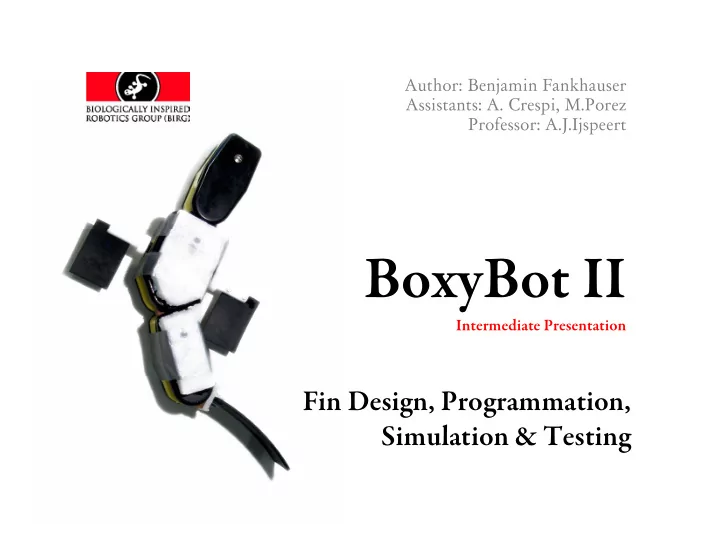

Author: Benjamin Fankhauser Assistants: A. Crespi, M.Porez Professor: A.J.Ijspeert BoxyBot II Intermediate Presentation Fin Design, Programmation, Simulation & Testing
Content Overview • General Design • Programmation using a CPG • Localization and Control • Fin Design & Testing – Resonance frequency – Efficiency Estimation • Simulation
Programmation using a CPG
Programmation using a CPG ∑ & φ = ω + ω ⋅ ⋅ φ − φ − ϕ ( r sin( )) [1] i i ij j j i ij j a = − − r a r ( R r ) r & & & i r i i i 4 a = − − x a x ( X x ) x & & & i x i i i 4 θ = + φ x cos( i ) i i θ = + ⋅ ω + φ lim ( t ) X R cos( t ) [2] i i i i 0 i , → ∞ t
Localisation and Control
Videos http://birg.epfl.ch/webdav/site/birg/users/196786/public/BoxyBotII%20 ‐ %20with%20Controller%20(5%20MB).avi http://birg.epfl.ch/webdav/site/birg/users/196786/public/BoxyBotII%20 ‐ %20without%20Controller%20(3%20MB).avi
Fin Design - Resonance Frequency 1 k = π ⋅ f r + 2 m m f a ⋅ ⋅ ⋅ 3 E I E w t = = k Spring Constant: ⋅ 3 3 l 4 l
Results – Fin Amplitude Fin 1 : 95x40 mm F R1 =0.7±0.1 Hz Fin 2 : 95x60 mm F R2 =0.6±0.1 Hz Amplitude vs. Frequency for fin 2
Simulation – Fin Amplitude Simulated and Real Amplitude vs. Frequency for fin 2 (F R2 =0.6 ± 0.1 Hz), Excitation Amplitude 40 ° , 60 ° and 80 °
Videos http://birg.epfl.ch/webdav/site/birg/users/196786/public/Simul ation%20 ‐ %20Freq%200.6%20 ‐ %20Resonance%20(1%20MB).avi http://birg.epfl.ch/webdav/site/birg/users/196786/public/Simul ation%20 ‐ %20Freq%201.2%20(1%20MB).avi http://birg.epfl.ch/webdav/site/birg/users/196786/public/Simul ation%20 ‐ %20Freq%201.8%20(1%20MB).avi
Results – Speed and Resonance Frequency Speed and Amplitude vs. Frequency for fin 2 (F R2 =0.6 ± 0.1 Hz), Excitation Amplitude 40 °
Results – Speed and Excitation Amplitude Speed vs. Frequency for fin 2 (FR2=0.6 ± 0.1 Hz)
Simulation and Reality - Speed Simulated and Real Speed vs. Frequency for fin 2, Excitation Amplitude 60 °
BoxyBot Swimming Behaviour
Videos http://birg.epfl.ch/webdav/site/birg/users/196786/public/BoxyBotII%20 ‐ %20CaudalFin%20BodySegment%20(3%20MB).avi http://birg.epfl.ch/webdav/site/birg/users/196786/public/BoxyBotII%20 ‐ %20Pectoral%20Fins%20(2%20MB).avi http://birg.epfl.ch/webdav/site/birg/users/196786/public/BoxyBotII%20 ‐ %20All%20Fins%20(3%20MB).avi
Efficiency Estimation ⋅ A f = St [3][4] Strouhal Number: v
Conclusion • BoxyBotII swims in a controlled manner • Fin Design – Resonance Frequency F R – Good Efficiency around F R – Use only Caudal Fins for Propulsion • Simulation – Comparable Amplitude Plot – Model needs Optimizing
Bibliography 1. A.Crespi, D.Lachat, A.Pasquier, A.J.Ijspeert: „Controlling swimming and crawling in a sh robot using a central pattern generator“, BIRG, School of Computer and Communication Science, Ecole Polytechnique Fédérale de Lausanne (EPFL), Switzerland, 2005 2. A. Crespi and A.J. Ijspeert. AmphiBot II: „An amphibious snake robot that crawls and swims using a central pattern generator“, in: Proceedings of the 9th International Conference on Climbing and Walking Robots (CLAWAR 2006), 2006. 3. S.Heo, T.Wiguna, H.Ch.Park, N.S.Goo: “Effect of an Artificial Caudal Fin on the Performance of a Biomimetic Fish Robot Propelled by Piezoelectric Actuators”, Journal of Bionic Engineering 4, 151 ‐ 158, 2007 4. J.J.Rohr, F.E.Fish: “Strouhal numbers and optimization of swimming by odontocete cetaceans”, The Journal of Experimental Biology 207 , 1633 ‐ 1642, 2004
Recommend
More recommend